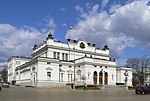Narodno Sabranie
| logo | Narodno Sabranie parliament building in Sofia |
|---|---|

|

|
| Basic data | |
| Seat: |
Sofia Bulgaria |
| Legislative period : | 4 years |
| MPs: | 240 |
| Current legislative period | |
| Last choice: | March 26, 2017 |
| Chair: | Tsveta Karajancheva |
| Distribution of seats: |
|
| Website | |
| www.parliament.bg | |
The Narodno Sabranie ( Bulgarian Народно събрание Narodno Sabranie , from Narod 'people' and Sabranie 'assembly') is the parliament of Bulgaria . The unicameral system applies . Since 1991 the National Assembly (also: People's Assembly) has consisted of 240 members.
There is also the Grand National Assembly ( Bulgarian Велико народно събрание ), which has 400 members; this is only responsible for changes to central constitutional principles and for the adoption of a new constitution. It is to be elected by resolution of the National Assembly and also exercises all the powers of the “ordinary” National Assembly for the time of its mandate. The National Assembly can amend or supplement all provisions of the Constitution, with the exception of those for which the Grand National Assembly is responsible (Articles 153–163 of the Bulgarian Constitution ).
history
The Bulgarian Parliament was first constituted with the Tarnowo Constitution of 1879. However, some historians give the meeting of 64 delegates of the revolutionary committees of the April Uprising of 1876 on Mount Oborishte as the First Bulgarian National Assembly. Originally, all men who were at least 21 years of age had the right to vote and vote. In 1944 women's suffrage was introduced. The deputies made decisions about the state budget, bills, government bonds, etc. The "Grand National Assembly", which was twice as large, elected the monarch or the regent, and approved constitutional amendments.
Today parliament is governed by the 1991 constitution (Articles 62 to 91). Parliament's primary role is to control the government and pass laws. The MPs themselves have a legislative right of initiative . The National Assembly currently has 240 members who are elected for four years by proportional representation in 31 multi-member constituencies. The allocation is based on the D'Hondt procedure . The constituencies are largely identical to the districts , only Sofia City consists of three constituencies, and Plovdiv City forms its own constituency. There is a threshold clause of 4 percent for the political parties . Government members are not allowed to belong to the National Assembly in the sense of a strict separation of office and mandate (Art. 68 Para. 2 of the Bulgarian Constitution).
architecture
The building in which the National Assembly meets is now a cultural monument. It was built between 1884 and 1886 according to the design of the architect Konstantin Jovanovič , who studied in Vienna and Zurich . The building was built in the neo-renaissance style. The interior was remodeled in 1961 and 1977, but the appearance was largely retained in its original form.
choice
The most recent election to the National Assembly took place on March 26, 2017.
President of the National Assembly (since 1990)
- Nikolay Todorow July 17, 1990–2. October 1991
- Stefan Sawow November 4, 1991-24. September 1992
- Aleksandar Jordanow November 5, 1992–17. October 1994
- Blagowest Sendow January 12, 1995-13. February 1997
- Jordan Sokolow May 7, 1997-19. April 2001
- Ognjan Gerdschikow July 5, 2001–4. February 2005
- Borislaw Welikow February 23, 2005–17. June 2005
- Georgi Pirinski July 11, 2005–25. June 2009
- Zezka Zacheva July 14, 2009–27. January 2017
- Dimitar Glawchew April 19, 2017–17. November 2017
- Zweta Karajancheva since November 17, 2017
Web links
- Narodno Sabranie
- History of the Narodno Sabranie (English)
- Historical pictures of the meeting
- 360 ° panorama
Individual evidence
- ↑ Claudia Weber: In Search of the Nation: Culture of Remembrance in Bulgaria from 1878-1944 . LIT Verlag Münster, 2006, p. 89. Hans-Joachim Härtel, Roland Schönfeld: Bulgaria: From the Middle Ages to the present . Southern Europe Society, Munich 1998, p. 116. Plamen K. Georgiev: The Bulgarian political culture . V&R unipress, 2007, p. 34 ff.
Coordinates: 42 ° 41 ′ 40 ″ N , 23 ° 19 ′ 58 ″ E


